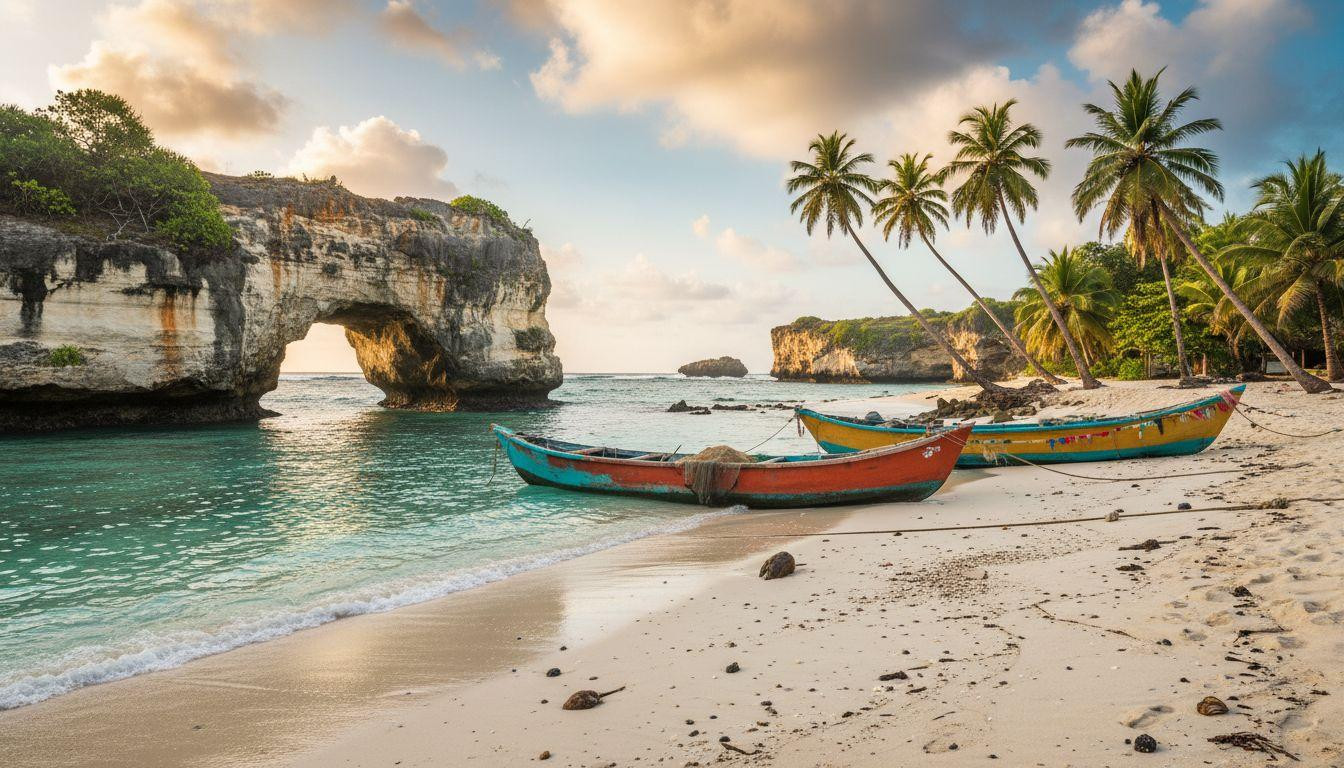This tiny island 25 miles from Port Blair welcomes fewer visitors in a year than Havelock sees in a month. Neil Island stretches just 5.3 square miles across turquoise Andaman waters, where 4,000 residents live unhurried lives among coconut groves and coral beaches. November marks the sweet spot when post-monsoon clarity meets pre-holiday calm, creating perfect conditions for discovering India’s quietest tropical escape.
Morning ferries from Port Blair carry 150 passengers maximum. The 90-minute journey reveals an island that tourism forgot to commercialize.
Where post-monsoon freshness meets turquoise calm
Neil Island sits 25 miles southeast of Port Blair in the Andaman Sea. Official name Shaheed Dweep honors freedom fighter Netaji Subhas Chandra Bose, though locals still say “Neil Island” in daily conversation.
November temperatures hover between 82-90°F during the day, cooling to comfortable 68-77°F evenings. Humidity drops significantly from monsoon levels, creating genuinely pleasant conditions. Post-monsoon vegetation glows vibrant green while underwater visibility improves 30-40% from October levels.
Government and private ferries depart Port Blair 5 times weekly. Economy class costs $5.40, premium runs $11.40. Private charters reach $216-300 for groups of 12. This Greek island of 200 people offers similar turquoise waters with authentic island rhythms.
Scooter rentals cost $3.60-4.80 daily from three main shops. Auto-rickshaws and shared taxis provide alternative transport across the 2.3-mile length.
The island Havelock was before tourism discovered it
Neil Island receives 40,000-60,000 annual visitors compared to Havelock’s 150,000+. This difference preserves authentic island character while delivering equivalent marine experiences.
Three beaches where crowds haven’t arrived
Laxmanpur Beach showcases dramatic rock formations and shallow turquoise water. The natural rock bridge “Howrah Bridge” stretches 82 feet, accessible during low tide. Morning light between 6:15-7:30 AM creates magical photography conditions with minimal crowds.
Sitapur Beach faces east for exceptional sunrise views at 5:58 AM. White silica sand mixed with coral fragments creates distinctive texture. Water reflections appear best 30-60 minutes after sunrise on calm days.
Bharatpur Beach extends 1,200 meters with family-friendly shallow waters. Lifeguards work November through April. This tiny island where turquoise water stays warm shares similar November appeal.
Marine life without marine tourism infrastructure
Underwater visibility reaches 15-18 meters in November, improving to 18-22 meters by December. Water temperatures stay comfortable at 81.5-85.1°F. Mahatma Gandhi Marine National Park borders the island, protecting extensive coral reefs.
Snorkeling tours cost $21.60-26.40 with maximum 8 participants. Scuba diving runs $222-270 for certification courses. Local operators report manta ray sightings increase November through January while parrotfish, angelfish, and sea turtles appear year-round.
What November reveals when 90% of visitors stay away
Ferry schedules determine island rhythm. Two to three daily arrivals contrast sharply with Havelock’s constant traffic. This creates space for authentic interactions with fishing communities and agricultural workers.
The authentic island rhythm
Fishing boats depart at 4:00 AM, returning between 4:00-5:30 PM with fresh catches. Daily produce markets run 6:00-9:00 AM. Shops operate 8:00 AM-8:00 PM without afternoon closures common elsewhere.
Local tourism boards confirm that Neil Island maintains traditional occupations alongside tourism. Fishing employs 35% of residents, agriculture 20%, with tourism accounting for 45%. These 5 islands stay 81°F through November while offering similar crowd-free experiences.
Genuine cost advantages
Budget accommodations range $18-36 nightly at family-run homestays with meals included. Mid-range options cost $42-84 for air-conditioned rooms with ocean views. Premium beachfront resorts run $95-180+ with spa facilities.
Fresh seafood curries cost $1.20-3 at local spots. Mid-range restaurant meals run $4.80-9.60. Premium seafood dinners reach $12-21.60. Fish curry with coconut milk, garlic crab, and prawn biryani represent signature dishes.
The quiet truth Havelock commercialized away
Neil Island operates in different temporal dimensions. Morning sounds include boat engines and fishermen preparing nets. By 9 AM, dominant sounds become waves, bird calls, and occasional scooters.
The sensory experience emphasizes absence: no traffic noise, no crowds, no commercial frenzy. Water temperature permits extended swimming sessions that transform recreation into meditation. Coral sand creates distinctive crunchy texture underfoot.
Evening gatherings at Bharatpur jetty showcase traditional wooden boats and fishing techniques passed through generations. Salt air mingles with coconut scents and evening curry preparation. This tiny island 10 miles from Tahiti offers similar authentic alternatives to overcrowded destinations.
Your questions about Andaman Neil Island answered
How do I actually get there and what does it cost?
Fly to Port Blair International Airport via Delhi, Mumbai, or Kolkata. Current flights cost $74-168 one-way. From Port Blair, take government ferries ($5.40 economy) or private boats ($216-300 charter). Total mid-range daily budget runs $84 including accommodation, meals, and activities.
Why November instead of peak season?
November offers optimal weather conditions with 82-90°F temperatures and significantly reduced humidity. Underwater visibility reaches 15-18 meters with calm seas perfect for diving and snorkeling. Tourist crowds remain 90% lower than December-January peak season while accommodation availability stays high.
What makes this different from Havelock?
Neil Island receives less than half of Havelock’s annual visitors while offering equivalent coral reefs and marine biodiversity. Infrastructure remains deliberately modest with 28 resorts versus Havelock’s 142. Cost advantages include 15-20% lower accommodation rates and 12-18% cheaper dining options.
At 5:15 PM, golden light transforms Laxmanpur’s turquoise water into amber-gold mirrors. Three fishing boats rest peacefully on the calm bay. Evening curry scents mingle with salt air while children’s laughter echoes from empty beaches. This represents the Andaman before tourism discovered it, still here, still quiet, still welcoming those who arrive first.
